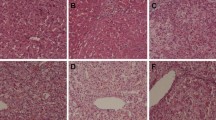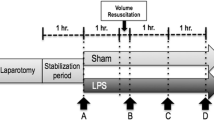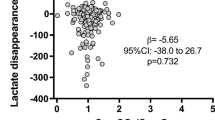Abstract
Objective: To characterize global, regional, and end-organ markers of cellular dysoxia during orthotopic liver transplantation and early reperfusion in pigs.
Design: Descriptive study.
Setting: University hospital research laboratory.
Animals and interventions: 7 fasted, anesthetized, and mechanically ventilated Yorkshire pigs underwent orthotopic liver transplantation. Oxygen consumption (VO2) and oxygen delivery (DO2) were both calculated using standard formulae. Gastric interstitial pH and the gastroarterial partial pressure of carbondioxide (PCO2) gradient were measured with a gastric tonometer. The following were determined from arterial blood samples: serum lactate to pyruvate ratio, serum 3-hydroxybu-tyrate to acetoacetate ratio, plasma free fatty acids, and plasma free and total carnitine levels.
Measurements and results: Data were collected 1 h after induction of anesthesia (I), at the end of the an-hepatic phase (A), and 1 h after reperfusion (R). Median (range) VO2 values obtained at the specified time points were: I 318 (206–1860), A 210 (152–408), R 330 (214–424) ml/kg per min, respectively (NS); DO2 values were: 11828 (1382–3259), A 1219 (452–2492), R 1741 (1345–12071) ml/kg per min, respectively (NS). The lactate to pyruvate ratio, reflecting the redox potential of the cytosol, progressively increased: I 22 (9–46), A 29 (16–68), R 43 (23–55) (P<0.05). Gastric interstitial pH, as well as the gastroarterial PCO2 gradient values at the specified time points did not reach statistical significance. Levels of ketone bodies (3-hydroxybutyrate+acetoacetate) remained lower than 0.120 mmol/1. The ketone body ratio did not significantly vary over time (NS). Plasma esterified and free carnitine concentrations and free fatty acid values remained within normal limits (NS). Among these markers, the ketone body ratio presented the largest area under the receiver operating characteristic curve as a marker of postoperative mortality, with an inflexion point at 0.9.
Conclusions: In this study, orthotopic liver transplantation was associated with significant variations over time in the redox potential of the cytosol. Postoperative mortality was, however, related to the redox state of the liver mitochondria. Our data suggest the occurrence of abnormal tissue oxygenation during liver transplantation.
Similar content being viewed by others
References
Nakano H, Boudjema K, Alexandre E, Imbs P, Chenard MP, Wolf P, Cinqualbre J, Jaeck D (1995) Protective effects of N-acetylcysteine on hypothermic ischemia-reperfusion injury of rat liver. Hepatology 22: 539–545
Shoemaker WC, Appel PL, Kram HB (1992) Role of oxygen debt in the development of organ failure sepsis, and death in high-risk surgical patients. Chest 102: 208–215
Friedman G, Berlot G, Kahn RJ, Vincent JL (1995) Combined measurements of blood lactate concentrations and gastric intramucosal pH in patients with severe sepsis. Crit Care Med 23: 1184–1193
Munoz JL, Ruza F, Lopez-Santamaria M (1996) Gastric intramucosal pH and lactate levels in an experimental model of intestinal ischemia. Intensive Care Med 22: S222
Schlichtig R, Tonnessen TI, Nemoto EM (1993) Detecting dysoxia in silent organ. In: Prough DS, Traystman RJ (eds) Critical care, state of the art. Society of Critical Care Medicine, Anaheim, pp 239–273
Taki Y, Ukikusa M, Morimoto T et al. (1987) Short term changes in blood ketone body ratio in the phase immediately after liver transplantation. Transplantation 43:350–353
Proulx F, Lambert M, Lacroix J, Nadeau D, Gauthier M, Qureshi IA (1997) Acquired carnitine insufficiency in children admitted to the pediatric intensive care unit. Eur J Pediatr 156: 864–869
Corbucci GG, Menichetti A, Cogliatti A, Nicoli P, Ruvolo C (1992) Metabolic aspects of acute tissue hypoxia during extracorporeal circulation and their modification induced by L-carnitine treatment. Int J Clin Pharm Res 12: 149–157
Rebouche CJ, Paulson DJ (1986) Carnitine metabolism and function in humans. Annu Rev Nutr 6:41–66
Oldhafer KJ, Hauss J, Gubernatis G, Pichlmayr R, Spiegel HV (1993) Liver transplantation in pigs. J Invest Surg 6: 439–450
Renner LE, Morton MJ, Sakuna GY (1993) Indicator, amount, temperature and intrinsic cardiac output affect thermodilution accuracy and reproducibility. Crit Care Med 21: 587–597
Marbach EP, Weil MH (1967) Repid enzymatic measurement of blood lactate and pyruvate. Clin Chem 13: 314
Takala J, Parviainen I, Siloaho M, Ruokonen E, Hamalainen E (1994) Saline PC02 is an important source of error in the assessment of gastric intramucosal pH. Crit Care Med 22:1877–1880
Williamson DH, Mellanby J (1974) 3-Hydroxybutyrate. In: Bergmeyer HU (ed) Methods of enzymatic analysis. Academic Press, New York, pp 1836–1839
Mellanby J, Williamson DH (1974) Acetoacetate. In: Bergmeyer HU (ed) Methods of enzymatic analysis. Academic Press, New York, pp 1446–1451
McGarry JD, Foster DW (1976) An improved and simplified radioisotopic assay for the determination of free and esterified carnitine. J Lipid Res 17: 277–281
Michalak A, Lambert MA, Dallaire L, Melançon SB, Laframboise R, Lemieux B, Qureshi IA (1990) Hypocarnitinémie chez les patients atteints d’un défaut primaire du métabolisme de l’ammoniaque traités avec le benzoate de sodium. Diabète Métab 16: 226–233
Hannon JP (1986) Hemodynamic characteristics of the conscious pig: a brief review. In: Tumbleson ME (ed) Swine in biomedical research. Plenum Press, New York, pp 1341–1352
Tiger F, Fouché R, Deloffre P (1995) La PCO2 tissulaire mesurée par tonométrie gastrique est dépendante du niveau de ventilation alvéolaire: intérêt du gradient gastroartériel en CO2. Réanimation Urgences 4: 748
Pinski MR, Matuschak GM (1995) Multiple system organ failure: failure of host defense homeostasis. Crit Care Clin 5:199–220
Hannon JP (1986) Hemodynamic characteristics of the conscious resting pig: a brief review. In: Tumbleson ME (ed) Swine in biomedical research. Plenum Press, New York, pp 1341–1352
Levett JM, Replogle RL (1979) Thermodilution cardiac output: a critical analysis and review of the literature. J Surg Res 27: 392–404
Gubernatis G, Bornscheuer A, Taki Y, Farle M, Lubbe N, Yamaoka Y, Beneking M, Burdelski M, Oellerich M (1989) Total oxygen consumption, ketone body ratio and a special score as early indicators of irreversible liver allograft dysfunction. Transplant Proc 21: 2279–2281
Albaladejo P, Jugan E, Descorps-Declere A, Jayais P, Ecoffey C (1994) Whole body oxygen uptake is not a good indicator of liver allograft function following orthotopic liver transplantation. Eur J Anaesthesiol 11: 201–205
Antonini M, Pastore E, Bufi M, Calzecchi E, Guerricchio R, DellaRocca G, Pinelli ML, Gasparetto A (1990) Hemodynamic and respiratory aspects in orthotopic liver transplantation. Minerva Anestesiol 56: 85–90
Hickman R, Stapleton GN, Mets B, Hlatshwayo S, Janicki P (1995) Hepatic blood flow during reduced liver grafting in pigs. A comparison of controls and recipients of intact allografts. Dig Dis Sci 40:1246–1251
Kindscher J, Hutchinson M, Levine J (1993) Is the ratio of venovenous bypass flow to cardiac output important during orthotopic liver transplantation. Transplant Proc 25:1824–1825
Grum CM, Fiddian-Green RG, Pittenger GL, Grant BJ, Rothman ED, Dantzker DR (1984) Adequacy of tissue oxygenation in intact dog intestine. J Appl Physiol 56:1065–1069
Guttierez G, Palizas F, Doglio G (1992) Gastric intramucosal pH as a therapeutic index of tissue oxygenation in critically ill patients. Lancet 339:195–199
Welte M, Pichler B, Groh J et al (1996) Perioperative mucosal pH and splanchnic endotoxin concentration in orthotopic liver transplantation. Br J Anaesthesia 76: 90–98
Mizock BA, Falk JL (1992) Lactic acidosis in critical illness. Crit Care Med 20: 80–93
Fernandez X, Meunier-Saloun MC, Ecolan P, Mormede P (1995) Interactive effect of food deprivation and agonistic behavior on blood parameters and muscle glycogen in pigs. Physiol Behav 58: 337–345
Karlsson T, Stjernstrom EL, Stjernstrom H, Wiklund L, Essen-Gustavson B (1995) Lactate metabolism and hypocarbic hyperventilation: an experimental study in piglets. Acta Anaesthesiol Scand 39:109–117
Mersmann HJ (1986) Lipid metabolsim in swine. In: Tumbleson ME (ed) Swine in biomedical research, Plenum Press, New York, pp 75–103
Hawker F (1993) The liver. Anatomy, physiology and biochemistry. In: Park GR (ed) The liver. Sanders, London, pp 1–42
Bucher T, Brauser B, Conze A (1972) State of oxidoreduction and state of binding in the cytosolic NADH-system as disclosed by equilibration with extracellular lactate-pyruvate in hemoglobin-free perfused rat liver. Eur J Biochem 27: 301–317
Fath JJ, Asher NL, Konstandinide FN, Bloomer J, Sharp H, Najarian JS, Cerra FB (1984) Metabolism during hepatic transplantation. Surgery 96: 664–674
Ozawa K, Aoyama H, Yasuda K, Shimahara Y, Nakatani T, Tamaka T, Yamamoto M, Kamiyama Y, Tobe T (1983) Metabolic parameters associated with postoperative organ failure. Arch Surg 118:1245–1251
Tanaka A, Kitai T, Iwata S et al (1993) Delayed oxidation of intramitochondrial pyridine nucleotide oxidoreduction state as compared with tissue oxygenation in human liver transplantation. Biochim Biophys Acta 1182: 250–256
Duée PH, Pegorier JP, Quant PA, Herbin C, Kohl C, Girard J (1994) Hepatic ketogenesis in newborn pigs is limited by low mitochondrial 3-hydroxy 3-methylglutaryl-CoA synthase activity. Biochem J 298: 207–212
Author information
Authors and Affiliations
Additional information
This study was made possible by the “Prix SPÉCIA”, granted from the “Société de Réanimation de Langue Française” (F.P.); and through special funding from Fujisawa Laboratories (T. Y.)
Rights and permissions
About this article
Cite this article
de Jaeger, A., Proulx, F., Yandza, T. et al. Markers of cellular dysoxia during orthotopic liver transplantation in pigs. Intensive Care Med 24, 268–275 (1998). https://doi.org/10.1007/s001340050564
Received:
Accepted:
Published:
Issue Date:
DOI: https://doi.org/10.1007/s001340050564




